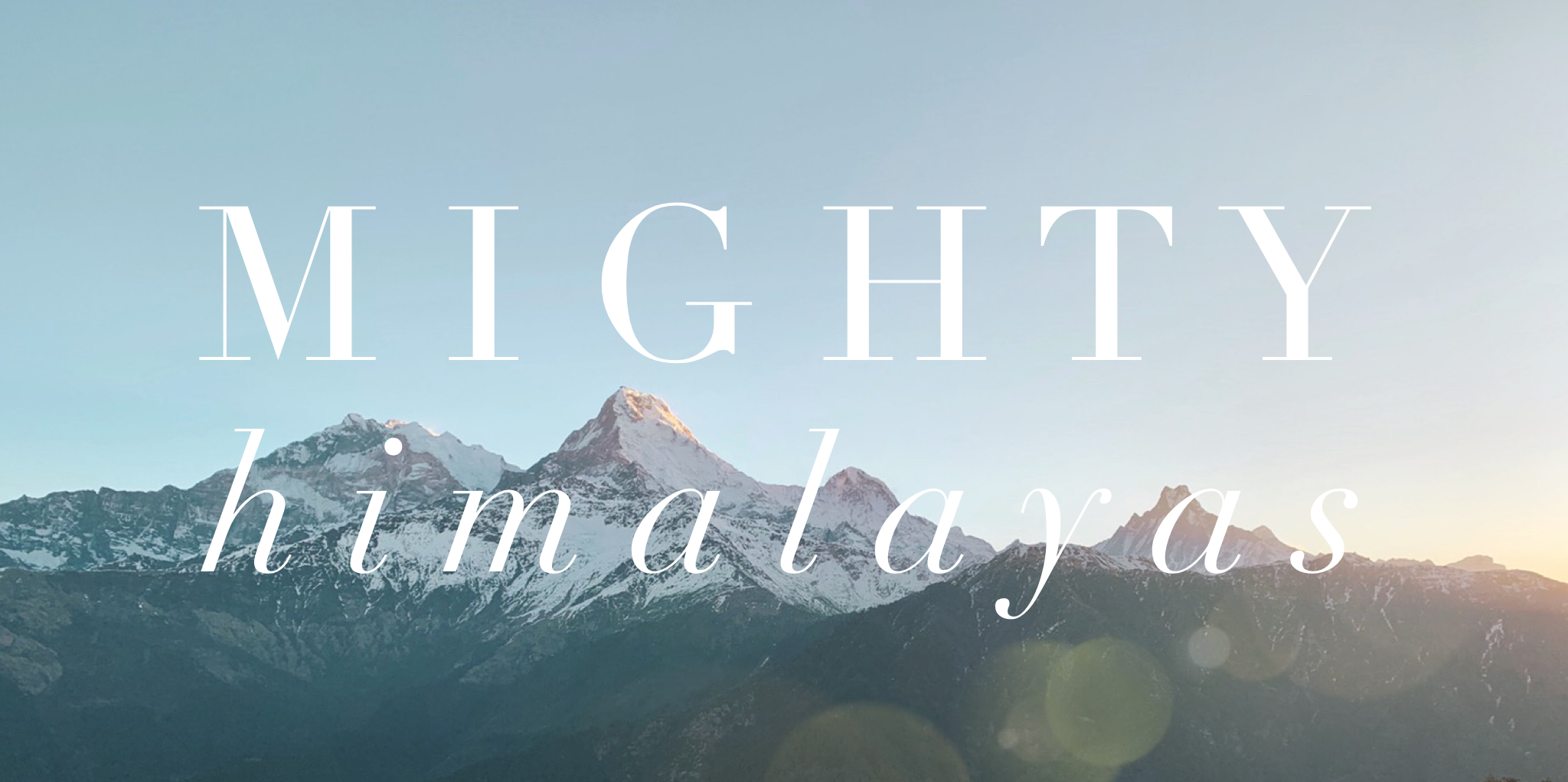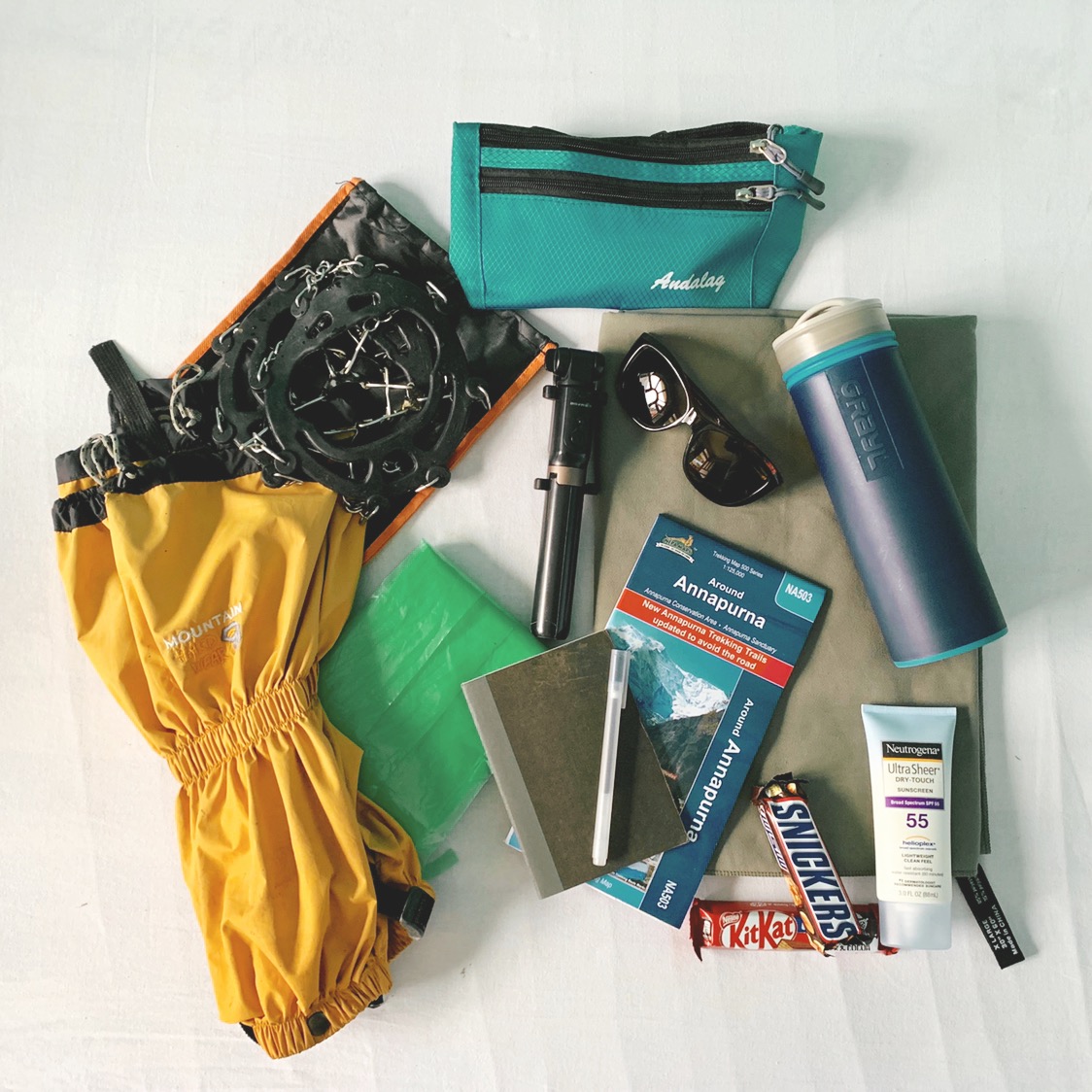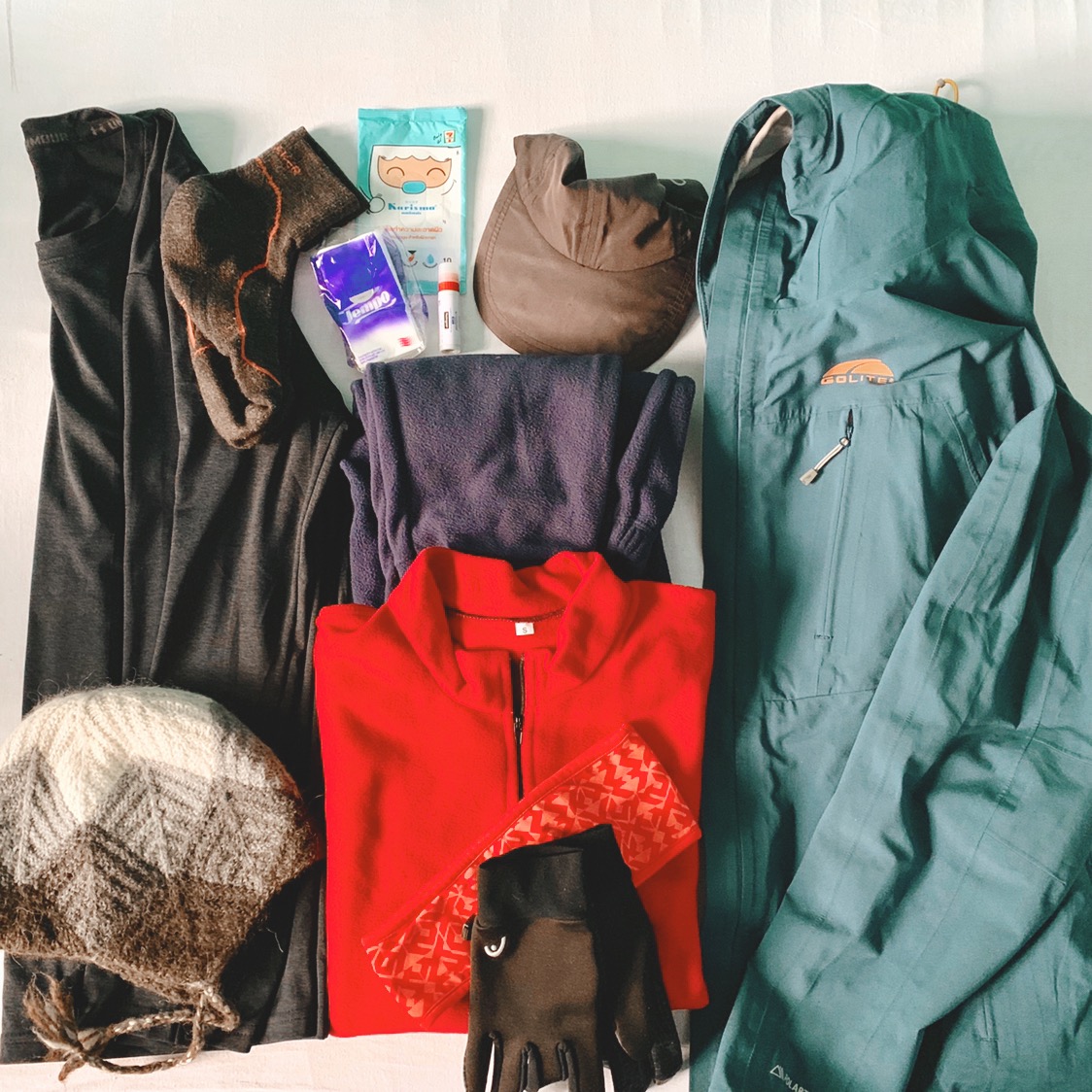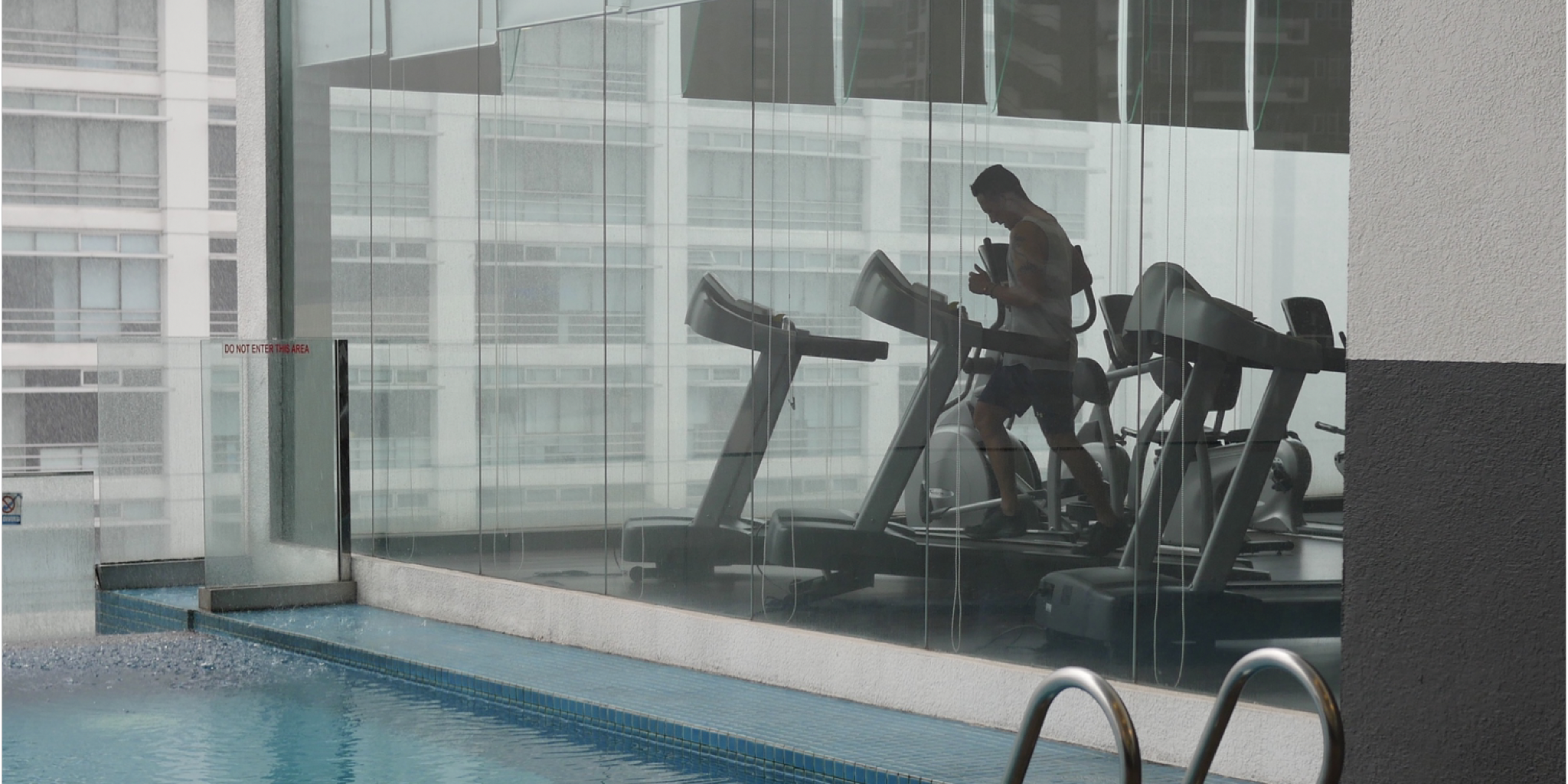Tips to make your first Nepal trek unforgettable
Before we started our World Trip we weren’t big on hiking. In fact, most of our outdoor activities were dragon boating and running. During this trip we found that trekking, especially multi-day treks, have a pace that really forces you to disconnect and slow down. Trekking the highest mountain range in the world did just that and we loved it so much we were already planning to return before we even left. Let’s get to the good stuff!
Here’s what we’ll cover:
What not to bring (you’d be surprised what other hikers bring)
What we wish we had, aka, our mistakes
What to Bring
If you are lucky, or don’t risk the shoulder season, you won’t need some of this gear. Let’s dive in!
Sleeping Bag & Poles: (not pictured) We rented both of these and would rent them again. We paid 5 USD for two -20C rated sleeping bags & 2 sets of poles - for 12 days = 60 USD. We definitely needed the sleeping bags b/c it was super cold and not all teahouses looked as clean. Fermin definitely used the poles, mostly on the downhills ‘cause we are getting old… and those joints man, they can take a pounding on the downhill. If you have a teeny tiny sleeping bag and poles already, then bring them, just bear in mind poles might not be carry-on approved in case you are planning to carry-on only.
Fanny pack: Yes, not the most stylish accessory you'll ever buy, but definitely the most convenient when you are hiking. This will be the easiest way to carry, and handily access your phone if you are planning to use it as your camera. We bought the one pictured above, in Kathmandu, for less than USD 5, but here’s a very similar one on Amazon if you'd rather buy before hand. It was slim and not too bulky so you didn't end up sweating too much.
Poncho: or you can improvise with a big plastic bag, that’s what we did and what is pictured above (the green looking bag). Or you can bring a poncho from home, just make sure it can cover your backpack. Most backpacks have a rain cover, especially the nice ones, but the straps will still get wet if it’s raining, the poncho covers everything nicely… and also makes you sweat more - pick your poison.
Water purifier/bottle: We bought the Grayl because we can filter and refill our other bottles. Plus, it filters heavy metals and not all filters do that. But we’ve seen other hikers with life straws and they like those purifies as well. This bottle with lifestraw was one we saw on the trail and seemed to work well.
Sunscreen & Chapstick: A total must! and you must reapply during the day too. Our skin is sensitive so Neutrogena works best for us. We buy this stuff at Costco but you can find a pack of 2, on Amazon, for about 15 USD. Most importantly, reapplying sunscreen also protects your skin from the windburn (or just sheer dryness of the mountains) so it’s double good!
Map: Buy this is Thamel (2–4 USD) or ask your tour company for one. It just makes it easier when talking to your guide about your next destination. Remember, Data/WiFi will not be available on the trails, and if you do get a tiny bit, it will be slow and spotty.
Snacks: Don’t go too crazy but definitely stock up on some of your faves! We also brought nuts but ate those before taking the photo above. If you are using a porter, be mindful of glass jars, we saw a group of along the trail and their porter was carrying lots of pickled looking glass jars (kinda like Kimchi but we don't know for sure) and cans. Yes you are paying for their service, but not to break their back, so be conscious.
Selfie stick: Super useful! Read our review here for more info.
Sunglasses: A must, especially if you encounter any snow, the sunny days can be super bright and you don’t want to damage your eyes. DO NOT buy these in Thamel. Make sure you bring, REAL, UV-Protecting, non-shattering sunglasses with you. Thamel is great for fake goods like crampons, gaiters and fanny packs, but NOT to protect your eyes.
Portable power bank: (not pictured) Charging in some places will be slow and/or not available. So we carried our power bank (read all about it here) just in case we couldn’t charge. Even having our phones on airplane mode most of the time, the battery still drained, so this came in handy a few times.
Journal and/or book: We journaled but a lot of travelers carried a real, physical, book. Kindle device might work, since it’s lighter generally, but just remember you might not be able to charge some days.
If you are going in the shoulder season, meaning just after before winter or just after it, we also recommend the following:
Gaiters: (the yellow-glove-looking item in the photo above) cover the tops of your shoes, and half of your leg so you don't get wet, in case there is about 30cm (1 foot) of snow. This helps a lot to keep your boots dry, or rather, less wet (if they are not waterproof). It also keeps you pretty warm. We bought these used ones for about 5 USD/ea in Chame - a small town on our trek. We didn't care they were used and kept us warm when we summited Poon Hill. You can also buy them on Amazon, here’s a similar model, but we’d suggest just buying them in the Thamel district, Kathmandu (where you’ll probably stay) b/c they are cheap and readily available.
Crampons: Crampons are super useful if there’s been a recent snow, it’s partially melted and now you are walking on a half frozen surface. As with the gaiters, we bought these in Chame, but you can find them much cheaper in Thamel, Kathmandu. If you are worried, these Amazon ones are similar to the crampons we bought in Nepal. Just bear in mind, you probably won’t be saving money by buying them at home.
Clothes: We went super minimalist on this trek and carried only 2 hiking sets of clothes. Meaning, we wore one, and carried one. This is what it meant for each of us:
Siori this means: 3 pairs of socks, 2 workout leggings, 2 long sleeve shirts, 1 skirt (last minute layer, but it was the best!), 1 fleece jacket, 1 down jacket & 1 water-resistant wind breaker. Plus 1 extra short sleeve shirt, fleece pants and top to keep warm at nights and undies, of course.
Fermin: 3 pairs of socks, 2 long johns, 2 pants, 2 long sleeve shirts, 1 down jacket & 1 water-resistant wind breaker. Plus a fleece pants & top to also keep warm, and undies.
We’d get to the teahouse and shower (if possible) or wet wipe, as soon as we could, before putting on our stylish fleece pants sets (that we bought in Thamel, Kathmandu for pretty cheap).
So, basically we recycled… A LOT. Did we stink? probably. We were super careful to not get veeeery sweaty during the day to avoid soaking our clothes in sweat, in hopes they'd get stinky less quickly. We think this helped keep the odor under control but who knows. If you are a particularly stinky person, whether you can smell yourself or others smell you, then you might want to bring more clothes, but we don't recommend bringing more than what we listed above.
Accessories: we both had beanies, gloves, and a scarf (not pictured) that we used as needed. At night especially, when the temperature drops, we definitely bundled up.
Wet wipes: Thankfully we had enough showers, but for the few nights the pipes were frozen, these guys saved the day! Siori finds it really hard to sleep when all salty so using these wipes at least felt better. You can definitely buys these in Nepal and no, you are not going to need a Costco-sized tub of ‘em.
Toiletries: Deodorant, soap, oil serum & a teeny Nivea cream tub - we talked about oil serums in our Toiletries for Her blog post, so you can read more about it there. So, no shampoo. We would’ve liked to take some shampoo but there were only a few places we could’ve washed our hair anyway, so we just didn’t. Neither one of us has a very oily scalp so it didn’t feel as gross as we thought, and we still rinsed it with water in the places were we could, so it wasn’t so dusty. Alternatively, we could've carried a shampoo bar, but we found them after this trek. Live and learn.
What you don’t need (but you think you do)
Too many toiletries - maybe a tiny bottle of shampoo, but forget all the other stuff. Or like we said above, a shampoo bar.
Too many changes of clothes - you’d be amazed how little you can survive with. Even if you hire a porter, you should still stay minimal - just ‘cause you are not carrying the weight doesn’t mean you should break someone else’s back, for a buck.
Glass, jarred, or canned food. The food at the teahouses is delicious and nutritious. Unless you have some kind of food allergy, brave it! You are here to experience the mountain, and this is very much a part of the trip.
What we forgot
Flip-flops: yea, not sure how that happened but we definitely missed these for some showers, and they really don’t take up that much room.
Flashlight: we only brought 1, for 2 people, and probably should've brought 1 for each. Not a big deal 'cause you still have your cellphone as a back up, but again, an extra one would've been nice.
Guides, porters & tipping
Guides: We hired a guide even though we initially were just going to follow the signs. We don’t regret this decision, especially when the weather turned and wasn’t so great, it was nice to be with someone who knew them mountain. That said, there’s a few things you should know:
You cannot pick your own teahouse - we were told we could, and for the most part we didn’t mind the teahouses our guide selected, but there were a few that we would’ve preferred to stay elsewhere. Guides have established relationships in each town and it’s hard for them to switch from where they normally stay. If there is an amenity (like a private bathroom) that’s really important to you, you should discuss this with your guide, before the trip starts. Our guide told us some towns don’t have teahouses with private bathrooms but given how many teahouses each town has, that’s hard to believe. Our bet is that he’s trying to protect his relationships and that’s totally understandable, just be aware sometimes you might stay in the grubbier looking teahouse.
Your guide is not your porter - our guide was nice enough to offer to carry one of our sleeping bags, but we declined. Not because we wouldn’t have liked to have a lighter load, but rather because if you needed a porter you should’ve hired one. Make sure you don’t abuse their kindness.
Porters: We chose to not hire a porter and in hindsight we are happy with that decision. For a bigger group, that might move too slow carrying their own weight, we'd recommend hiring porters b/c 1) it helps the local economy and 2) it might make your experience more enjoyable if you are less tired from not carrying that weight. Just please, please be mindful of how much you give your porter. Our recommendation is, if you wouldn't carry it yourself, you should not give it to them. Also, the porter ratio is usually 1 porter for 2 hikers, so imagine they are actually carrying twice whatever weight you'd carry if you follow our recommendation. We saw a lot of what looked like overburdened porters who probably took the job b/c it puts food on the table; just keep this in mind.
Tipping: Our agency recommended a tip of 10% (given we didn’t have a porter) the value of the tour. In our case that came to 95 USD which we rounded to 100 USD. What we heard from other travelers was 3-5 USD/day for your guide and 2-4 USD/day per porter. By the latter, we over tipped, but we felt it was a fair amount given how many days our guide spent with us and was away from home.
What about you? any tips for trekking in Nepal? leave ‘em in the comments below.
* Unless otherwise noted, the products we recommend are the ones we are using and bought ourselves. Some items on this blog post may include affiliate links to Amazon and its affiliate sites. The links won’t cost you any extra because the commission is paid by the retailer but it will help us run our blog. So, many thanks in advance if you do use our links! See our Affiliate Marketing page for more info.








